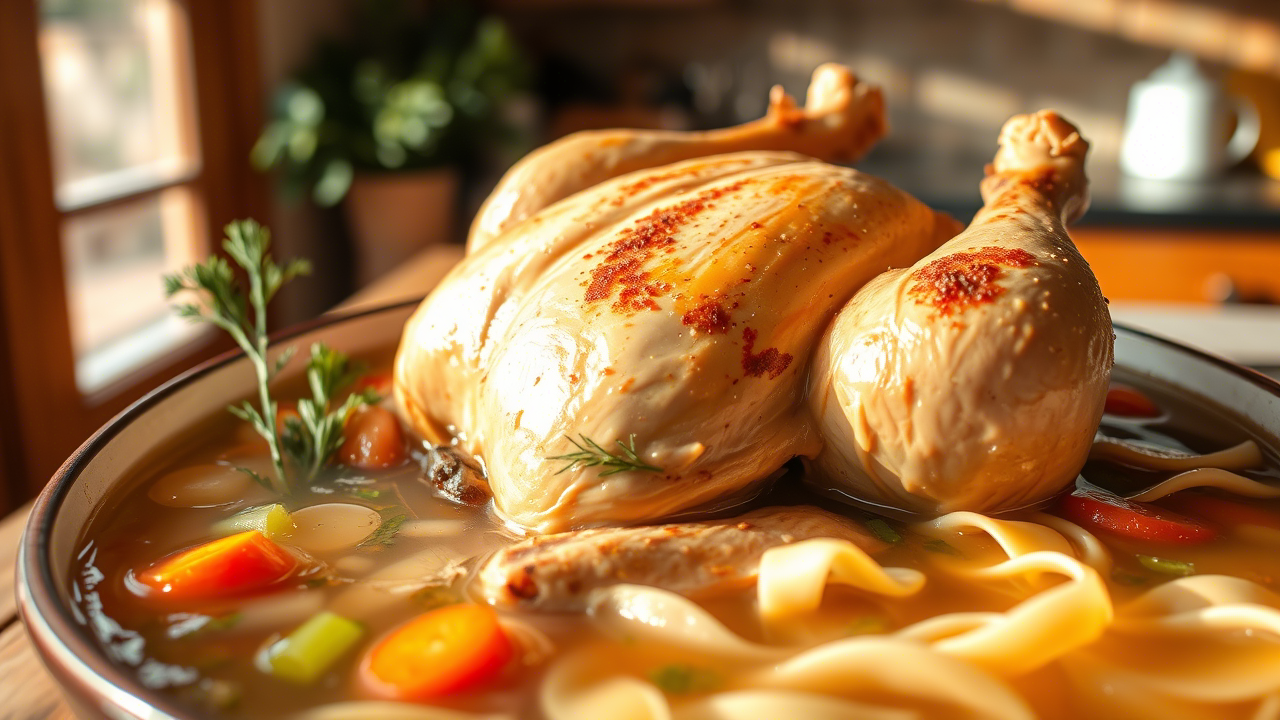Make homemade chicken noodle soup with a whole chicken — rich, healthy, and perfect for cozy nights or immune-boosting comfort.

There’s just something about a steaming bowl of chicken noodle soup from scratch that soothes the soul. Whether you’re battling a cold or just craving a comforting meal, this timeless classic hits the spot. But what if you could take that flavor to the next level? You absolutely can, and you can use a whole chicken, too.
This guide will walk you through the step-by-step process of making a rich, nourishing, and deeply flavorful soup. We’re not talking canned shortcuts here. Nope! We’re going full-on homemade — from boiling the chicken to slicing fresh herbs and tossing in those slurp-worthy noodles. You’ll learn why starting with a whole bird makes all the difference, how to build a broth that sings, and what tweaks can personalize it for your taste.
So grab a pot, tie your apron, and let’s dive into the cozy world of homemade chicken noodle soup — with a wholesome twist.
Homemade Chicken Noodle Soup
If you’ve ever sipped soup that warmed you from the inside out, chances are it had something special going on — homemade chicken stock. And guess what? That magic? It starts with a whole chicken. No mystery powders. No artificial flavors. Just good, honest ingredients bubbling away on your stove.
This recipe isn’t just about filling your belly. It’s about filling your home with the kind of aroma that makes people say, “What are you cooking?!” It’s about embracing slow food that’s worth the wait. And trust us — once you try this, there’s no turning back to bland store-bought broth.
Why Use a Whole Chicken for Chicken Noodle Soup?
Using a whole chicken in soup isn’t just old-school — it’s genius. You’re not only getting juicy, tender meat, but also drawing deep, rich flavor from the bones and skin. As the chicken simmers, all those nutrients and savory notes meld into the broth, creating a silky base that no boxed stock could dream of matching.
And let’s not forget about value! With one bird, you’re getting broth, meat, and the foundation for tomorrow’s meal — maybe even the next day’s too.
Flavor Depth That Stands Out
There’s a reason chefs swear by bone-in chicken soup. As bones cook slowly, they release gelatin and collagen. That’s what gives your soup that luscious mouthfeel. You’ll taste the difference with every spoonful. It’s not just soup. It’s comfort in a bowl.
More Nutrition in Every Bite
You’re not only getting flavor — you’re getting fuel. The broth gains calcium, magnesium, and trace minerals from the simered bones. Plus, real veggies and fresh herbs pack it with antioxidants and vitamins. It’s immune-boosting chicken soup you can feel good about.
A Budget-Friendly Classic
Purchasing an entire chicken is frequently less expensive than buying separate parts.You stretch it further, waste less, and make more — and who doesn’t love getting more bang for their buck?
Ingredients for the Best Homemade Chicken Noodle Soup
To create an unforgettable homemade chicken noodle soup with a whole chicken, you need more than just poultry and pasta. It’s the layers — the bones, herbs, veggies, and noodles — that come together like a flavorful symphony. Here’s how to pick each ingredient like a pro.
You don’t need fancy, rare stuff. Just honest ingredients that shine when cooked with care. The right ones make all the difference between a bland broth and a bowl of magic.
Whole Chicken: The Star of the Show
Your soup’s depth starts with the bird. A fresh whole chicken, skin on, bone in, will give you the full flavor spectrum. Don’t toss out the neck or giblets — they’re gold for broth! Roast them first if you want extra richness, but they also do wonders raw.
What to Look For:
Fresh, not frozen if possible
Organic or free-range for better flavor
3–4 lbs is ideal for a family-sized pot
Using a whole bird means you get both white and dark meat. That’s balance, baby. Juicy bites of thigh and leg? Yes, please.
Aromatics and Vegetables
No soup is complete without its fragrant backbone. The classic trio — carrots, celery, and onion — builds the foundation of that comforting, nostalgic taste. But hey, don’t be afraid to throw in extras if you’ve got them!
Core Veggies:
2–3 medium carrots, peeled and chopped
2 celery stalks with leaves for extra herbiness
1 large onion, quartered
4–5 garlic cloves, smashed (not minced — let them melt into the broth)
Want more flavor? Add a piece of fresh ginger or a teaspoon of turmeric. Both provide a delicate zing and a warm, golden tint.
Herbs That Elevate the Flavor
Herbs can make or break your chicken soup from scratch. Use a mix of woody and fresh varieties. Bay leaves and thyme go in early. Parsley and dill jump in at the end — bright and fresh.
Must-Have Herbs:
2 bay leaves
A few sprigs of fresh thyme
Handful of parsley, chopped
Optional: dill or rosemary for boldness
If you want it herbaceous but balanced, don’t go overboard. Let the chicken lead, herbs support.
Noodles: The Soul-Satisfier
Ah, noodles — the slurpy stars that soak up broth and flavor. Classic egg noodles work great, but homemade pasta? Even better.
Popular Choices:
Wide egg noodles (classic)
Fusilli or rotini for a modern twist
Homemade noodles if you’re feeling ambitious
Cook them separately if you’re storing leftovers. Nobody likes soggy noodles tomorrow.
Optional Add-Ins to Make It Yours
This soup is your canvas. Add in what feels right for your family, your mood, or your pantry.
Lemon juice or zest for a bright pop
Corn kernels for a sweet crunch
Chopped spinach or kale for extra nutrition
A pinch of crushed red pepper for warmth
Tips for Selecting the Best Whole Chicken
Now let’s talk shopping. Not all chickens are created equal. Here’s how to pick the best bird for the job.
What to Ask or Look For:
Freshness: Avoid grayish or dull skin
Size: 3–4 pounds feeds 6+ servings
Source: Organic, pasture-raised, or local birds often yield richer broth
If possible, get your chicken from a butcher or a farmer’s market. You’ll taste the difference, especially in a from-scratch chicken noodle soup where every ingredient shines.
Step-by-Step Preparation Process
How to Make Chicken Noodle Soup with a Whole Chicken
Alright, apron on? Knife in hand? Let’s make the kind of chicken noodle soup from scratch that makes you go, “Whoa, I did that.” Don’t worry — it’s way easier than it sounds. Just follow these steps, and you’ll be slurping homemade goodness in no time.
Prepare the Whole Chicken
Start by rinsing your whole chicken under cold water. Remove the giblets if they’re inside (sometimes in a little bag). Don’t toss them! They’re packed with flavor. Set them aside to add to your broth.
Place the chicken in a large soup pot — one that holds at least 6 to 8 quarts. You’ll need room for veggies, water, and lots of love.
Quick tip: Trim off extra fat and skin if you like a leaner broth. But leave enough for richness.
Making the Broth from Scratch
Now the magic begins. Toss the chicken in the saucepan with your aromatics, which include garlic, onions, carrots, celery, and herbs like thyme and bay leaves.
Pour enough water into the pot to completely submerge the bird.
Usually 10 to 12 cups does the Heat it over medium-high heat until it gently boils.
Turn down the heat to low as soon as it begins to bubble. This step’s crucial! A slow simmer draws out all the flavor. A fast boil just makes cloudy, flat broth.
Let it simmer, uncovered, for at least 90 minutes. Skim the surface occasionally with a spoon to remove any foamy stuff (aka impurities).
Add a little apple cider vinegar as a bonus flavor enhancer; it helps draw minerals out of the bones.
Straining and Shredding the Chicken
Once the chicken is fall-off-the-bone tender and your kitchen smells like heaven, it’s time to separate the gold.
Carefully lift the chicken out with tongs or a slotted spoon and set it on a cutting board. Let it cool for a few minutes. You’ll want to avoid scalding your fingertips.
Pour the broth into a second big saucepan after straining it through a fine mesh screen.This removes all the soft veggies and bits, leaving a clear, silky broth.
Now shred that chicken! Remove the skin and bones, then pull the meat into bite-sized chunks. Dark meat, white meat — it all goes back into the soup.
Pro tip: Save the bones to make more homemade stock later!
Adding Vegetables and Noodles
Put your beautiful broth back on the stove and boil it gently.
Add fresh chopped carrots and celery now. Allow them to cook for 10 to 12 minutes, or until they are just tender. No one likes mushy veggies, right?
Next, toss in your noodles. If you’re serving right away, go ahead and cook them directly in the broth. For leftovers, cook them separately to keep them from soaking up too much liquid.
Don’t forget: Add your shredded chicken back in during the last few minutes so it warms through but doesn’t overcook.
Seasoning and Final Touches
This is where you fine-tune the flavor.Taste as you go and add salt and pepper gradually. A little lemon juice adds brightness, while fresh parsley or dill gives it that herbaceous finish.
Want to kick it up a notch? A pinch of turmeric adds warm color and earthiness. Feeling adventurous? A small pinch of onion or garlic powder gives depth without being overbearing.
And there you have it — a from-scratch chicken noodle soup with a whole chicken that’s comforting, nourishing, and bursting with flavor.
Cooking Tips and Variations
Expert Tips for a Perfect Soup Every Time
So, you’ve mastered the base. Great! But wait — there’s more to perfect homemade chicken noodle soup than just tossing things into a pot. With a few smart tricks, you can take your soup from great to unforgettable.
Avoiding Overcooked Noodles
Ever had noodles that went mushy overnight? Ugh, right? The fix is easy — cook them separately if you’re making enough for leftovers. Just add a scoop to each bowl when serving.
If you’re eating it all in one go (we get it, it’s that good), go ahead and boil them in the broth. But keep a close eye — egg noodles can go soft in minutes.
Go Low and Slow with the Broth
Patience really does pay off. The longer you simmer your whole chicken, the richer your broth will be. The gelatin from the bones really comes through at this point, giving your soup its smooth, rich texture.
And here’s the deal: don’t boil like a maniac. A rolling boil just breaks down the meat too fast and turns broth cloudy. Keep it at a slow simmer — steady bubbles, low heat, deep flavor.
Make-Ahead and Freezer-Friendly Advice
You can totally prep this soup in advance. It may even taste better the next day.
To store:
Cool soup completely before refrigerating
Store noodles separately for best texture
In the refrigerator, it keeps for up to four days.
To freeze:
Skip the noodles (they don’t freeze well)
Freeze broth and shredded chicken in airtight containers
Reheat slowly, then add cooked noodles when serving
Common Mistakes to Avoid
Even a classic like chicken noodle soup from scratch has a few traps. Here’s how to sidestep them and keep your soup game strong.
Boiling Instead of Simmering
We’ve said it before, but it’s worth repeating. Boiling your soup = cloudy, flat, sad broth. Simmering = clear, rich, soul-hugging flavor.
If your pot is bubbling hard, turn down that heat! A gentle simmer lets everything infuse slowly and deeply.
Skipping the Skim
You’ll notice a bit of foamy stuff rising to the surface as your chicken simmers. That’s just protein and fat. Skim it off with a spoon now and then. It keeps your soup looking clean and tasting clean.
Overloading with Ingredients
It’s tempting to toss in every veggie in the fridge, but less really is more. Stick to the classics — carrots, celery, onions — then add just one or two custom touches. You want balance, not chaos.
Variations of the Recipe
Soup is meant to be flexible. Once you nail the base, you can remix your homemade chicken noodle soup with a whole chicken into something uniquely yours.
Lemon Chicken Noodle Soup
Add fresh lemon juice and a bit of zest to your broth just before serving. This version is bright, zippy, and immune-boosting — especially great for cold season.
Spicy Thai-Inspired Chicken Soup
Swap parsley for cilantro, add a spoonful of red curry paste, and toss in some chopped chili or fresh ginger. Boom — a spicy twist that warms you head to toe.
Gluten-Free or Low-Carb Options
Watching your carbs? No problem.
Sub in zucchini noodles or spaghetti squash
Use gluten-free pasta
Skip noodles altogether and bulk up with more veggies
This is your soup — own it, tweak it, love it.
Storage, Reheating & Leftovers
How to Store Chicken Noodle Soup Properly
Made a big batch of homemade chicken noodle soup with a whole chicken? Nice work! Now let’s make sure none of it goes to waste.
This soup holds up beautifully if you store it the right way. The key is keeping textures just as delicious on day three as they were on day one.
Refrigerator Storage Tips
Once your soup cools to room temperature, store it in airtight containers. Use glass jars, meal-prep bowls, or plastic containers with tight-fitting lids.
Pro tip: Store the noodles separately. That way, they won’t soak up all your broth and turn into mushy messes.
Noodle-free soup keeps for four to five days in the refrigerator.
Cooked noodles: best within 2 days
Chicken (if stored separately): up to 4 days
Always label with the date. Trust us, your future self will thank you.
Freezing Your Homemade Soup
It is possible to freeze homemade chicken noodle soup, but not with the noodles.
To freeze properly:
Cool soup completely
Remove the noodles (or skip them during cooking)
Transfer the chicken and broth to zip-top bags or freezer-safe containers.
Soup swells when frozen, so leave space at the top!
How long will it keep? Up to 3 months.
Thaw overnight in the fridge before reheating. For a quicker fix, run the container under warm water to loosen, then reheat gently on the stove.
Reheating Tips Without Losing Texture
Nobody wants rubbery chicken or soggy noodles. So when it’s time to bring your soup back to life, be gentle.
Here’s how to reheat like a soup whisperer:
On the stove: Simmer gently over medium-low heat. Stir occasionally. Don’t boil.
In the microwave: Use a microwave-safe bowl. Heat in 30-second bursts, stirring between rounds.
Pro tip: Reheat noodles separately, then ladle hot soup over them in your bowl. Boom — perfect texture every time.
And hey — don’t forget a sprinkle of fresh herbs or a squeeze of lemon before serving. A simple refresh like that brings your leftover chicken soup right back to peak deliciousness.
Nutritional Information & Benefits
Is Chicken Noodle Soup Healthy?
You bet it is. A big, warm bowl of homemade chicken noodle soup with a whole chicken isn’t just cozy — it’s seriously good for you. Unlike store-bought versions packed with sodium and preservatives, making soup from scratch means you control everything.
It’s hearty. It’s wholesome. It’s also packed with nutrients that your body truly needs.
Why It’s a Classic Cold-Fighting Soup
Ever wonder why people always bring you chicken soup when you’re sick? It’s not just tradition — it’s science. This soup checks all the boxes when it comes to supporting your immune system.
Here’s what makes it a natural immune-booster:
Whole chicken bones release collagen and gelatin, which help repair your gut and reduce inflammation
Vital vitamins A, C, and K are added by celery, carrots, and garlic.
Hot broth helps clear nasal passages and soothe sore throats
Plus, it’s light on your stomach while still giving you energy. Win-win.
Calories and Nutritional Breakdown
Of course, nutritional info can vary depending on your ingredients, but here’s a rough breakdown for one generous serving of soup (about 1.5 cups):
| Nutrient | Amount (Approx.) |
|---|---|
| Calories | 220–280 kcal |
| Protein | 22–25 grams |
| Fat | 8–12 grams |
| Carbohydrates | 18–22 grams |
| Fiber | 2–3 grams |
| Sodium (low-salt broth) | ~400–600 mg |
Note: Using skinless chicken and whole-grain noodles makes it even healthier. And skipping salt-heavy bouillon cubes or canned broth keeps your sodium levels in check.
A Complete Meal in a Bowl
With lean protein, fresh vegetables, and complex carbs, this soup is a full meal. No need to add anything (except maybe a crusty slice of bread on the side, if you’re feeling fancy).
And unlike heavy cream-based soups, this one keeps things light, hydrating, and easy on your gut.
Bottom line? Whether you’re under the weather, short on time, or just need comfort in a cup — this healthy chicken noodle soup with a whole chicken has got your back.
Frequently Asked Questions
Frequently Asked Questions
People love chicken noodle soup — and naturally, they have a few questions before diving in. Below, you’ll find clear, no-fluff answers to the most common queries about making homemade chicken noodle soup with a whole chicken.
Can I use a whole chicken in chicken noodle soup?
Absolutely — and honestly, you should. Using a whole chicken adds way more flavor than boneless cuts. You get rich broth from the bones, tender meat from every part, and bonus nutrients, too. Plus, it’s more cost-effective and makes a larger batch.
For the best results, simmer it low and slow to extract all that goodness. Trust us — once you try it, you’ll never go back.
How long should I cook a whole chicken in soup?
For full flavor and fall-apart tenderness, simmer your whole chicken for 90 minutes to 2 hours. That’s the sweet spot where the meat stays juicy and the broth turns golden and flavorful.
Keep the pot uncovered and the heat low. A gentle simmer is key to drawing out everything the chicken has to offer — from juicy meat to collagen-rich bones.
Should I cook the noodles separately or in the soup?
Both ways work — but it depends on when you’re eating it.
Same-day meal? Cook noodles directly in the soup. Easy and tasty.
Meal prep or leftovers? Boil noodles separately and store them apart. They won’t later become mushy or absorb too much broth that way.
Either way, it’s a win — just depends on your plan.
What herbs go best in chicken noodle soup?
The traditional ingredients of parsley, thyme, and bay leaves are incomparable. If you’re feeling adventurous, add a little rosemary or dill. Adding fresh herbs at the end gives your homemade chicken noodle soup a burst of aroma and freshness.
Avoid dried herbs early on unless they’re robust like bay or thyme. Delicate ones like parsley and dill are better added just before serving.
Can I freeze chicken noodle soup?
You sure can — but hold the noodles.
To freeze properly:
Let the soup cool completely
Remove or skip the noodles
Portion into freezer-safe containers
Freeze for up to 3 months
When you’re ready to enjoy it again, thaw overnight and reheat gently on the stove. Add fresh-cooked noodles at the last minute for best texture.
Final Thoughts & Serving Suggestions
Serving Suggestions for Homemade Chicken Noodle Soup
You’ve simmered, shredded, seasoned, and stirred. Now, the best part — serving your homemade chicken noodle soup with a whole chicken. While this dish is undeniably satisfying all by itself, pairing it with the right sides takes things up a notch.
Here are some cozy, comforting ideas to round out the meal:
Crusty bread or garlic toast: Perfect for dunking and soaking up every drop of that golden broth.
Simple green salad: A light, fresh contrast to the warm richness of the soup.
Saltine crackers or oyster crackers: Classic, crunchy, and nostalgic.
Grilled cheese sandwich: Go big or go home — soup and grilled cheese? Yes, please.
Don’t forget to top your soup with a sprinkle of chopped parsley, a dash of black pepper, or even a squeeze of lemon for a fresh kick.
Final Thoughts
Making homemade chicken noodle soup with a whole chicken isn’t just cooking — it’s a ritual. It’s how you show love, slow down, and feed both body and soul. Every stage, from the initial simmer to the final spoonful, enhances flavor, coziness, and contentment.
This isn’t fast food. It’s feel-good food. The kind that fills your kitchen with warmth, your table with smiles, and your fridge with meals that last for days.
So the next time life calls for something cozy, something healing, or something deeply delicious… you’ll know exactly what to make.
Here’s to big pots, bold flavors, and a timeless soup that never goes out of style. 🥣





